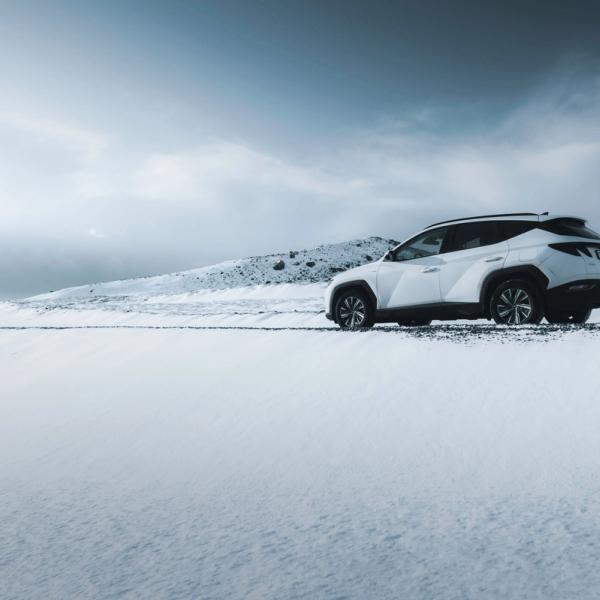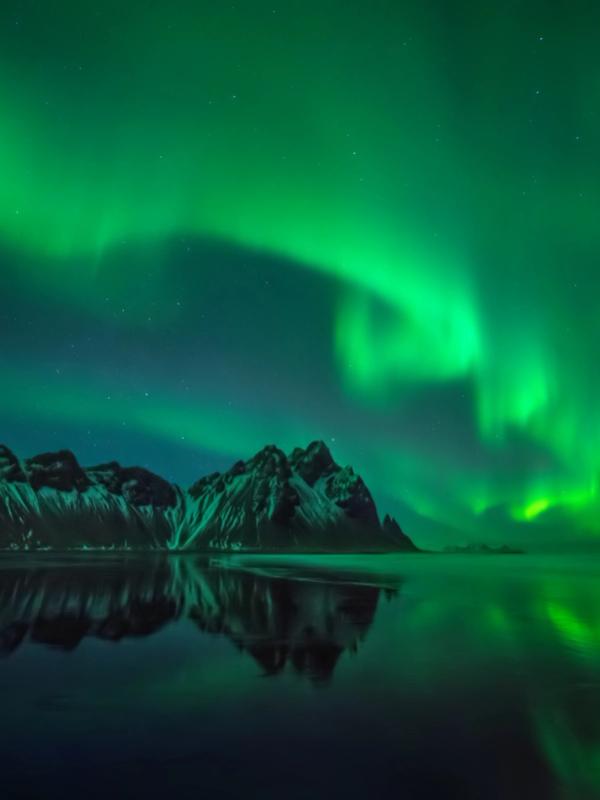
Northern Lights in Iceland: The Ultimate Travel Guide for 2025-26
Iceland is hands down one of the best places to see the Northern Lights. It's up north, gets super dark in winter, and doesn't have much light pollution; perfect for catching that amazing light show in the sky. Here's what you need to know to plan a trip.
What Are the Northern Lights?
The Northern Lights (or Aurora Borealis if you want to get fancy) are basically colored lights that dance around in the night sky. They occur when particles from the sun collide with gases in our atmosphere.
It's pretty "simple":
- The sun shoots out particles
- These particles zip through space to Earth
- Earth's magnetic field pulls them toward the poles
- When they hit gases in our air, they make colored lights
- You'll mostly see green, but sometimes pink, purple, or even red
The end result looks like curtains of light dancing in the dark. Iceland sits right under the "auroral oval," the ring where all this action happens most often.
Why Iceland Is a Great Place to See the Northern Lights
Iceland is one of the top spots in the world to catch the aurora for a few simple reasons:
- Perfect location - Iceland sits right under where the Northern Lights are most visible. The whole country gets good views.
- Super dark nights - From November through January, it's dark for up to 19-20 hours a day. That gives you tons of time to spot the lights.
- Not many lights - Most of Iceland is really dark; no streetlights or city glow to block your view.
- Easy to get to - Unlike many aurora spots, Iceland has good flights from major cities and decent roads that stay open year-round.
- Cool backgrounds - You can see the lights reflecting in glacier lagoons, framed by volcanoes, or above waterfalls - way better than just an empty sky.
Best Time to See the Northern Lights in Iceland
You can only see the Northern Lights in Iceland from late August through early April. Summer nights are too bright because of the midnight sun.
Here's a month-by-month breakdown:
| Month | Darkness Hours | Aurora Activity | Weather | Crowds | Verdict |
| September | 10-12 hours | High | Mixed, often rainy | Low | Great shoulder month |
| October | 12-14 hours | Very High | Best clarity of autumn | Medium | Hidden gem |
| November | 16-19 hours | Very High | Cold & clear spells | Medium | Sweet spot |
| December | 19-20 hours | Peak | Lots of snow storms | High | Magical but crowded |
| January | 18-20 hours | Peak | Coldest, clearest | Medium | Photographer's dream |
| February | 14-16 hours | Very High | Stable cold | Medium | Excellent |
| March | 12-14 hours | High | Snow melting, windy | High | Still great |
| April | 8-10 hours | Moderate | Getting brighter | Low | Last chance |
Good news if you're going in 2025-2026: we're at a solar maximum (the sun's most active phase), which means more frequent and brighter displays than we've seen since 2003-2004.
Time of Day
Northern Lights usually appear between 9 PM and 2 AM, with most activity happening around 11 PM to midnight. But they can pop up any time it's dark, so keep your eyes on the sky all night if you can.
Best Places to See the Northern Lights in Iceland
You can potentially see the Northern Lights anywhere in Iceland when conditions are good. But some spots are better than others because they're darker or have cooler scenery.
Jökulsárlón Glacier Lagoon (South Iceland)
This place is magical for aurora viewing.
The glacier lagoon works like a mirror for the lights, with icebergs floating in the foreground. It's about 4 hours and 45 minutes from Reykjavík, but it's worth the drive if you're serious about seeing the best views.
What you need to know:
- Amazing for photos - icebergs reflect the green lights
- Super dark skies
- You can also visit nearby Diamond Beach
- You'll need to stay overnight in the area
- Best as part of a multi-day South Coast trip
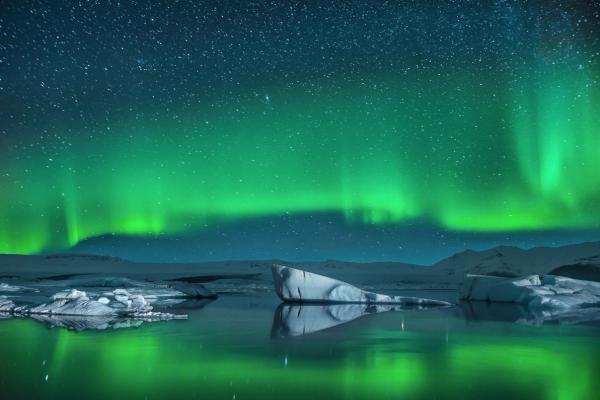
Kirkjufell Mountain (Snæfellsnes Peninsula)
This cone-shaped mountain is probably in half the Northern Lights photos you've seen from Iceland.
It's on the north coast of the Snæfellsnes Peninsula (about 2.5 hours from Reykjavík). There's also a small waterfall nearby that adds to the photos.
What you need to know:
- The most photographed mountain in Iceland
- Close enough for a day trip from Reykjavík
- Very dark skies
- Parking area gets crowded on aurora nights
- Popular with tour groups

Thingvellir National Park (Golden Circle)
Part of the popular Golden Circle route and just 45 minutes from Reykjavík, Thingvellir is super easy to get to for aurora viewing.
It's a UNESCO World Heritage site where two tectonic plates meet. The combo of history and dark skies makes it popular for people with limited time.
What you need to know:
- Closest dark-sky area to Reykjavík
- Cool historical site
- Lake reflects the auroras
- Gets crowded on nights with good forecasts
- Any rental car can make it here

Reynisfjara & Vík (South Coast)
The black sand beach near Vík, with its basalt columns and sea stacks, makes a dramatic setting for the Northern Lights.
About 2 hours and 30 minutes from Reykjavík, this area has very dark skies and those iconic black beaches that photographers love.
What you need to know:
- Black sand looks amazing against green aurora
- Sea stacks make cool silhouettes
- Very dark once you're away from town
- Easy to reach on south coast day trips
- Watch out for sneaker waves - they're dangerous even at night

Westfjords (Remote Northwest)
If you want peace and quiet with your aurora experience, the remote Westfjords have pristine dark skies and dramatic fjord landscapes.
This less-visited region takes longer to reach (6+ hours from Reykjavík or a domestic flight), but you get absolute darkness and unique scenery.
What you need to know:
- Zero light pollution
- Hardly any other tourists, especially in winter
- Dramatic fjord landscapes
- You'll need a 4x4 vehicle in winter
- Always check road conditions before heading out
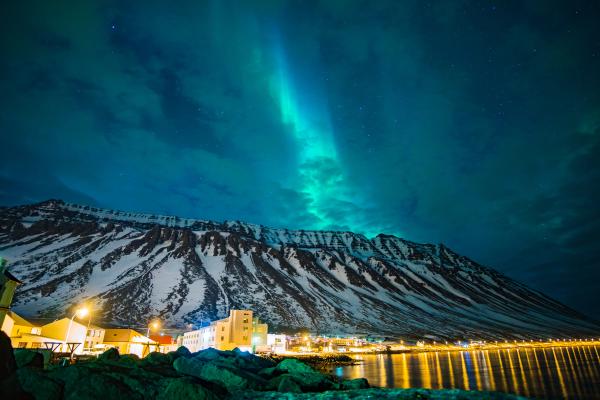
Akureyri & Lake Mývatn (North Iceland)
North Iceland often has clearer winter skies than the south, making it a good bet for aurora hunting.
The area around Akureyri (Iceland's second city) and Lake Mývatn has hot springs, lava formations, and good infrastructure, along with excellent aurora viewing spots.
What you need to know:
- Often clearer weather than South Iceland
- You can combine aurora viewing with hot springs
- Plenty of good places to stay in Akureyri
- You can fly there from Reykjavík
- Mývatn Nature Baths stay open late for night sky viewing

Grótta Lighthouse (Reykjavík Area)
Not everyone can leave the city, but you can still see auroras from certain spots in Reykjavík.
Grótta Lighthouse at the tip of Seltjarnarnes (just 12 minutes from downtown) is the most popular city spot, with ocean views and less light pollution.
What you need to know:
- Best aurora viewing spot within Reykjavík
- Easy to reach by city bus or a short drive
- No special vehicle needed
- Needs stronger aurora activity to be visible through city lights
- Lots of locals come here on forecast nights
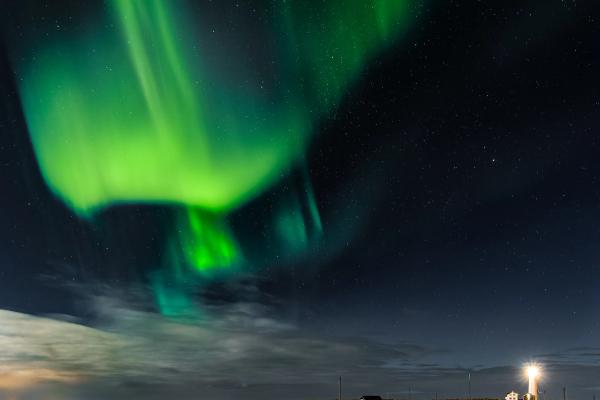
Northern Lights Tours vs. Self-Drive
One of your biggest choices when planning is whether to join guided tours or drive yourself. Each has pros and cons depending on how comfortable you are with winter driving, your budget, and what kind of experience you want.
Self-Drive Aurora Hunting
If you're comfortable driving in winter conditions, self-driving gives you total freedom.
Pros:
- Go wherever and whenever you want
- Avoid crowds for quieter viewing
- Hit multiple spots in one night
- Chase clear skies based on forecasts
Cons:
- Winter driving can be scary (snow, ice, strong winds)
- You need to figure out forecasts yourself
- It can be risky in remote areas at night
Tips for self-driving:
- Always rent a 4x4 for winter
- Check road.is before heading out
- Have a full tank, charged phone, and emergency stuff
- Don't stop on highways - find safe pullouts
Guided Northern Lights Tours
If winter driving isn't your thing or you want local expertise, guided tours are great. Most tours follow a similar pattern: they check the weather and the aurora forecasts during the day, pick you up from your hotel in the evening, and take you to the location with the best viewing conditions that night. A huge advantage is the "free retry policy": if you don't see the lights, most companies let you join another tour for free on a later night.
Here are your options:
- Large Bus Tours (69-89$)
- Cheapest way to go
- They'll pick you up from your hotel
- Usually offers a free retry if you don't see the lights
- Guides explain the science and stories
- You might end up at spots with other tour buses
- Small-Group Minibus Tours (119-149$)
- More personal (8-18 people)
- More flexible to chase clear skies
- Often include hot drinks, snacks, and photos
- Guides help with camera settings
- Worth the extra money for a better experience
- Super Jeep Tours (200-250$)
- Premium experience in modified 4×4 vehicles
- Small groups (6-8 people)
- Expert guides who know all the local spots
- Can go on rough tracks regular cars can't handle
- Often stay out longer if conditions look promising
- Northern Lights Boat Cruises (115$)
- Unique experience watching lights reflect on water
- Get away from city lights without long drives
- Heated cabins when you get cold
- Most boats serve drinks and snacks
- Different vibe combining aurora viewing with a night at sea
- Multi-Day Tours
- Maximize your chances by combining day sightseeing with nightly aurora hunting
- Visit remote areas like the South Coast, Snæfellsnes, or Lake Mývatn
- The package includes accommodation, transportation, and activities
- Multiple nights boost your chances of seeing the lights
- Good value if you want a complete Iceland winter experience
If it's your first time in Iceland, starting with a guided tour gives you valuable local knowledge and safety, even if you plan to self-drive later. Guides also make the experience better by sharing Icelandic stories and photo tips while keeping you comfortable in the cold.
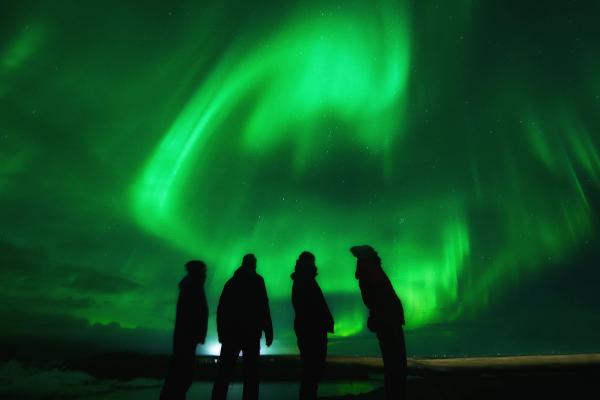
Weather and Forecasting
Clear skies are absolutely essential for seeing the Northern Lights. Even the strongest aurora will be invisible behind clouds. Iceland's weather changes fast, so planning is key:
Checking Forecasts
These tools will help maximize your chances:
- Icelandic Met Office (vedur.is) - Their aurora forecast has:
- Cloud cover map (green areas = clear skies)
- Aurora forecast (Kp index and oval position)
- Updates every 30 minutes
- Aurora Apps
- "Hello Aurora" (made by Icelanders)
- "My Aurora Forecast"
- "Aurora Alerts"
- These send notifications when conditions look good
- Real-time aurora data - For the really dedicated:
- SpaceWeatherLive.com - shows solar wind conditions
- NOAA's OVATION aurora model
Understanding the Kp Index
The Kp index (0-9 scale) measures geomagnetic activity:
- In Iceland, you can often see auroras with just Kp 2-3
- Kp 4+ means strong activity visible even near cities
- Kp 5+ can produce multi-colored displays
During the 2025 solar maximum, even moderate Kp readings can create amazing displays.
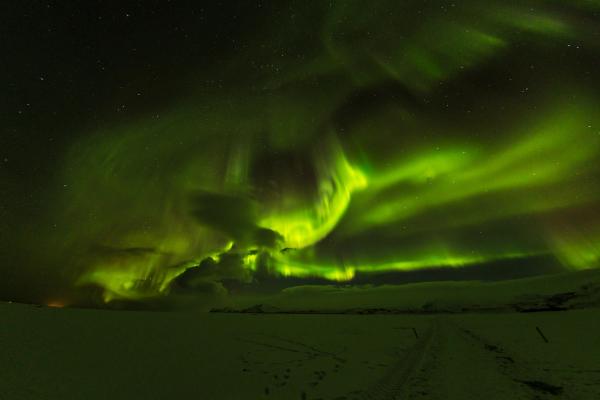
Tips to Maximize Your Chances
Stay multiple nights
The #1 strategy for seeing the Northern Lights in Iceland is to stay for multiple nights. Tour operators' statistics show that three nights give you a 78% chance of success, five nights jump to 93%, and a whole week reaches 99%.
Be flexible with your plans
Keep your evening schedule flexible. Don't book activities that can't be changed when aurora conditions look good.
Get away from light pollution
Location really matters when hunting for auroras. Even driving just 15-30 minutes outside towns dramatically improves visibility by getting away from light pollution.
Check forecasts daily
Check the Icelandic Met Office aurora forecast daily, with cloud cover being even more important than the Kp index. Clear skies matter more than strong aurora activity.
Be patient & bring supplies
You'll need patience for aurora hunting. The lights often appear suddenly after hours of waiting, so bring hot drinks and snacks to stay comfortable. Hand warmers in your gloves and boots can keep you out there longer on cold nights.
Dress extremely warmly
Dress in layers: a thermal base layer, a fleece mid-layer, an insulating down or synthetic layer, and a waterproof/windproof outer layer. Don't forget good boots, gloves, and a hat.
Let your eyes rest
When you reach your viewing spot, allow your eyes to adjust to the darkness for at least 15-20 minutes. Avoid looking at your phone screen or other bright lights, as they can reset your night vision.

Northern Lights Photography
You can capture the Northern Lights with most modern cameras and even smartphones. Here's how:
Camera Setup
- What you'll need:
- Camera with manual mode (DSLR or mirrorless works best)
- Wide-angle lens (14-24mm)
- Sturdy tripod
- Remote shutter or 2-second timer
- Extra batteries (cold drains them fast)
- Camera settings:
- Switch to manual mode
- Aperture: as wide as possible (f/1.8-f/2.8 is best)
- ISO: start at 1600-3200
- Shutter speed: 5-15 seconds (shorter for fast-moving auroras)
- Manual focus set to infinity
- Composition tips:
- Include an interesting foreground (mountains, water, people)
- Rule of thirds works well (sky in upper two-thirds)
- Try both horizontal and vertical shots
Smartphone Photography
Modern phones can take decent aurora photos:
- Use Night Mode or download an app (like NightCap for iPhone)
- Mount your phone on a mini tripod (super important)
- Use a 10-15 second exposure
- Focus manually on a distant light or star
- Don't expect pro results, but you'll capture the memory
Common Mistakes to Avoid
- Forgetting to remove filters from lenses
- Using autofocus (it doesn't work in the dark)
- Not checking test shots for focus
- Touching the camera during exposure (causes blur)
- Looking at bright LCD screens (ruins night vision)
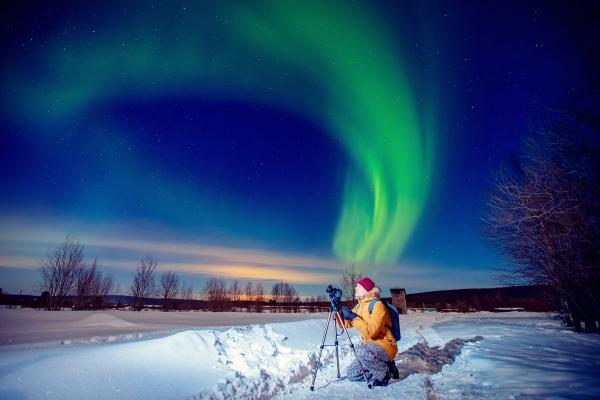
Icelandic Culture and Aurora Folklore
Icelanders have cool stories about the Northern Lights:
- In Norse mythology, people thought the lights were reflections from Valkyrie armor as they rode across the sky
- Some tales linked the lights to spirits of the dead
- A common old belief warned pregnant women not to look at the aurora, or their babies might be born cross-eyed
- Other legends said the lights were caused by elves or hidden people celebrating
- Unlike some cultures that were scared of the lights, Icelanders generally saw them as good signs
Today, the Northern Lights are a big part of Iceland's identity as a place of natural wonders.
Planning Your Trip
A good Northern Lights trip needs planning beyond just aurora viewing. Iceland's winter conditions, remote locations, and costs require thoughtful preparation to ensure you have a good time and don’t go over budget.
Budget Breakdown
A 7-night Northern Lights trip to Iceland typically costs between 1,650-2,300€ per person during aurora season. You can save money by staying in a mix of hotels and guesthouses, and by shopping at budget supermarkets like Bónus instead of eating out every meal.
- Flight to Keflavík: 180-420€ from Europe and 300-650$ from the USA
- Car rental 4×4 automatic: ~80$/day
- Fuel for Ring Road loop: ~230$
- Accommodation mix: ~125$/night
- Northern Lights tour (backup option): 120$
- Food (supermarkets + occasional restaurants): ~350$
Essential Apps and Tools
Technology helps a lot with aurora hunting success and safety in Iceland. The Icelandic Met Office website has aurora and cloud forecasts in one place, while road.is gives real-time updates on driving conditions. Most of Iceland has good 4G coverage, but consider getting a local SIM card to stay connected.
- Vedur.is (Icelandic Met Office)
- Aurora Forecast & Alerts
- Road.is (live road conditions)
- 112 Iceland (emergency app)
- Straeto.bs (bus routes if not driving)
Safety Considerations
Iceland's landscapes are perfect for aurora backdrops but come with winter challenges. The weather can change fast, with strong winds and sudden snowstorms. When aurora hunting, always dress much warmer than you think you need to. Standing still in the cold for hours can lead to hypothermia if you're not properly dressed.
- Never underestimate Icelandic weather
- Always check road.is before traveling
- Let someone know where you're going when heading to remote areas
- Keep emergency supplies in your car
- Stay on marked paths
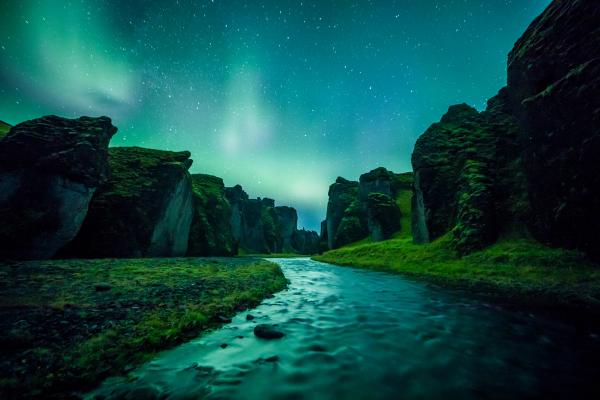
Conclusion
Iceland is one of the world's best places to see the Northern Lights. With its location under the auroral oval, dark winter skies, and minimal light pollution, you've got a great chance of seeing this magical phenomenon. The 2025-2026 solar maximum makes this an ideal time to plan your trip.
Remember these key points:
- Visit between September and March
- Stay at least 3-5 nights to increase your chances
- Check cloud forecasts daily
- Get away from city lights
- Dress super warm
- Be patient, nature runs on its own schedule

